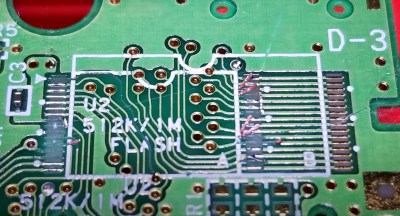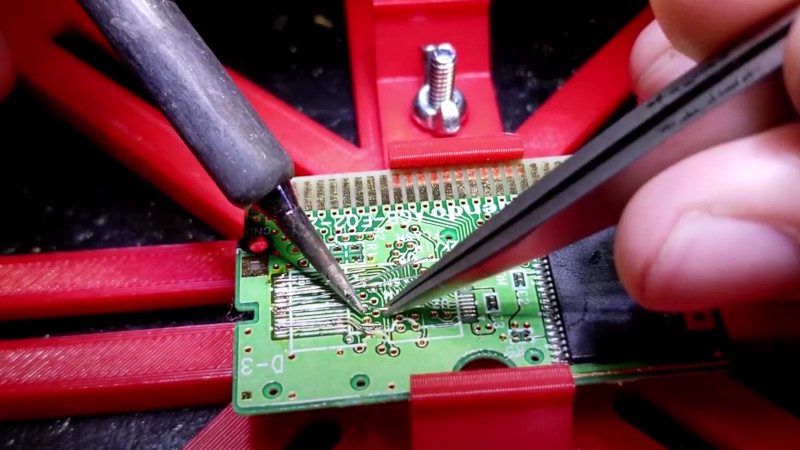The flash chips used in Game Boy Advance (GBA) cartridges were intended to be more reliable and less bulky than the battery-backed SRAM used to save player progress on earlier systems. But with some GBA titles now hitting their 20th anniversary, it’s not unheard of for older carts to have trouble loading saves or creating new ones. Perhaps that’s why the previous owner tried to reflow the flash chip on their copy of Golden Sun, but as [Taylor Burley] found after he opened up the case, they only ended up making the situation worse.

When presented with so many damaged traces on the PCB, the most reasonable course of action would have been to get a donor cartridge and swap the save chips. But a quick check on eBay shows that copies of Golden Sun don’t exactly come cheap. So [Taylor] decided to flex his soldering muscles and repair each trace with a carefully bent piece of 30 gauge wire. If you need your daily dose of Zen, just watch his methodical process in the video below.
While it certainly doesn’t detract from [Taylor]’s impressive soldering work, it should be said that the design of the cartridge PCB did help out a bit, as many of the damaged traces had nearby vias which gave him convenient spots to attach his new wires. It also appears the PCB was designed to accept flash chips of varying physical dimensions, which provided some extra breathing room for the repairs.
Seeing his handiwork, it probably won’t surprise you to find that this isn’t the first time [Taylor] has performed some life-saving microsurgery. Just last year he was able to repair the PCB of an XBox controller than had literally been snapped in half.
















I’ve repaired a number of pc engines that have been previously reworked. They’re not too bad, but this process can always take more time than it’s really worth.
The important thing about this is archival. A lot of these old games arent able to run anymore because of failing hardware. There are some games on the NES that weren’t archived in time to beat the clock on their lifespan, so the game is lost to time.
If we can figure out how to work out this problem, archival for history’s sake will be much more possible.
I picked up a cheap PG Engine GT that didn’t work. It was worked on before but it seemed like someone used the big soldering iron for pipes to recap the GT. That one took me a very long time to make it work, replacing all those cheap caps with proper quality cap and repairing damaged traces. Lack of schematic was of no help with power supply and backlight driver.
It wouldn’t be the first time I’ve put in a lot of jumper wired to replace burnt out or damaged traces from a slipped screwdriver or heat pealed component removal. But sadly these days my eyes and shakey hands won’t let me to the fine detailed soldering that Taylor has managed here. For that reason I stick to DIP and through hole these days. The smalles SMD parts may as well essentially be magical dust and cake sprinkles.
+1
Sprinkles….
Here’s a rework tip: if 30AWG wire is too large, get yourself some heat-strippable magnet wire (36 to 40 AWG). It is NOT cheap! But the smaller size makes it quite handy for really fine repairs.
Good source of fine magnet wire… old headphone speakers!
Another good source is miniature relays. Coils for >12V are often wound with 50µm or even finer wire.
If you don’t need insulation, such as crack/corrosion bridging, strands from small guage stranded core wire work swell
This. I’m using strands from 22 gauge copper to repair a Neo Geo MVS 2 slot as my current project. Battery corrosion on these can be devastating, and there are tons of very fine pitch data lines nearby.
1) love the comment about magnet wire aka coil wire
2) the reason its expensive is noone buys it! why pay money when theres a glut of it in almost EVERYTHING, everyone already has more then a lifetime supply of it and would NEVER need to buy, and with everything’s powersupplys switching to SMPS (no pun intended), everyone has plenty of super-fine ready-to-go, err actually, ready-to-unwind.
3) also, thank you YUP, i always forget about headphone elements, the most fine, so fine its delicate, but ive always gotten away with other sources, signal inductors and SMPS transformers. just remember that if your looking to build a custom SMPS transformer, you have to use a core from a POWER inductor/transformer, not a signal inductor, im not sure if u can use the core from a signal transformer tho.
And make sure it’s low temp enamel so the soldering iron easily melts it. High temp enamel is a PITA
I may be misremembering the whole thing here, but most GBA carts have a PCB that is shared with many other games, there was a chart that told you which ones
Certainly. Pokemon games are among rare ones that can’t be replaced easily, and even then you can try japanese copy as a donor which usually costs a fraction of an english copy. Golden Sun has no special components like a clock or sun sensor so there are probably dozens of shovelware games that can be used as donors.
Sure, but then you’ve got to swap both chips. If you get another copy of the same game, you just need to replace the EEPROM to move the save over.
It’s worth noting that, at least in this case, the EEPROM holding the saves still seemed to be good. It just needed to get soldered properly.